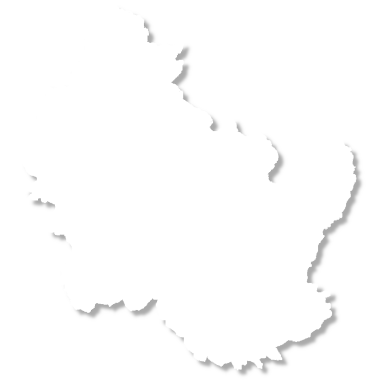The Ribeira Sacra e Serras do Oribio e Courel Biosphere Reserve
Canyons, mountains, plains, and valleys, and an exceptional richness of flora and fauna combined with a living cultural legacy. The Ribeira Sacra e Serras do Oribio e Courel Biosphere Reserve was created by UNESCO because of the set of unique characteristics found in this territory.
The boundaries of the Ribeira Sacra e Serras do Oribio e Courel Biosphere Reserve incorporate the central parts of the Miño River and Sil River watersheds, and also those of their tributaries: the Lor River, Cabe River, and others. The reserve is structured into three large landscape units: canyons, plains and valleys, and mountains.
The Sil Canyon and the banks of the Miño River are some of the most characteristic and exceptional natural elements, where spectacular rocky landscapes, forests, and terraced vineyards coexist with a remarkable richness of cultural heritage sites, such as historic monasteries, churches, and villages.
The reserve covers 306,535 hectares, which is about 10% of Galicia’s total land area. It is spread across 23 municipalities in the provinces of Lugo and Ourense, with 18 of these belonging to the Ribeira Sacra “geodestination” (Bóveda, Carballedo, Chantada, Monforte de Lemos, Pantón, Paradela, A Pobra do Brollón, Portomarín, Quiroga, Ribas de Sil, O Saviñao, Sober, and Taboada in Lugo; and A Peroxa, A Teixeira, Castro Caldelas, Nogueira de Ramuín, and Parada de Sil in Ourense).
The boundaries of the reserve also incorporate a total of 9 protected spaces: Courel Mountains Geopark, Faro Mountain Special Area of Conservation (SAC), Pena Veidosa SAC, Cabe River SAC, O Courel SAC, Sil Canyon SAC, Bidueiral de Montederramo SAC, Campodola-Leixazós Fold Natural Monument, and Loio-Ruxidoira Natural Area of Local Interest.
In terms of flora and fauna, this is Galicia’s most rich and diverse space.
The confluence of oceanic and Mediterranean climates in this area, sharp temperature changes between winter and summer, the presence of limestone outcropping, and highly complex topography with substantial variations in elevation are some of the factors that have led to the presence of 1,214 species of flora, which is more than half the diversity existing in all of Galicia.
This richness is so great that more than 60% of the flora found in Galicia as a whole is present within the reserve’s territory. About one-quarter of the reserve is covered by various types of forest or groves of trees, which contain more than 50 species of trees and shrubs. Some of the most prominent within these habitats are heather, alder, ash, and yew.
In the eastern area of the reserve, more specifically the O Courel Mountains, the high number of orchids is most notable, with up to 22 species.
In addition, these highly diverse habitats and ecosystems, and their state of preservation, have also allowed a high level of faunal biodiversity, with almost 300 species. In this territory there are 169 species of birds, 62 species of mammals, 20 species of reptiles, 14 species of amphibians, and 12 species of fish.
Iconic animals such as wolves and wildcats make their home in this territory, and it is one of the last strongholds of the brown bear in Galicia.
A cultural legacy formed by centuries of history
The results of 2,500 years of history are revealed through archaeological sites in the form of megalithic monuments, Bronze Age settlements, and Castro culture hillfort villages, along with others sites reflecting the presence of Roman legions here at the western edge of the Roman Empire. The presence of religious hermits seeking seclusion and monastic communities also played an important role throughout the territory of the reserve, and it is known to have one of the highest concentrations of rural Romanesque architecture in Europe.
Within the boundaries of the reserve you will find a rich cultural heritage that includes castles, churches, bridges, watermills, manor houses, dams, agricultural terraces, Roman mines, medieval towns, and much more, which all combine to create this extraordinary historical and cultural reality. Finally, we cannot forget to mention that two Routes of Santiago de Compostela (also known as the Way of St James or Camino de Santiago), included on the UNESCO World Heritage List since 1993, also pass through the reserve, namely the French Route and Winter Route.
The value of these lands and the cultural treasures they contain has led to designation of Ribeira Sacra as a Spanish Asset of Cultural Interest in the Cultural Landscapes category.
But above all else, Ribeira Sacra is a living community, with more than 75,000 residents who contribute to preservation of these landscapes and their natural and cultural value.
Don't miss!
But... what is a biosphere reserve?
The Spanish Biosphere Reserve Network (RERB) defines Biosphere Reserves as territories created with the aim of producing harmony between preservation of biological and cultural diversity and economic and social development, by promoting relationships between people and nature.
They are established in areas that are ecologically representative, or that present unique value, whether on land, along coastlines, or in marine environments. Integrating the local human populations and their activities into ongoing conservation efforts is considered to be essential.


 Interactive map
Interactive map